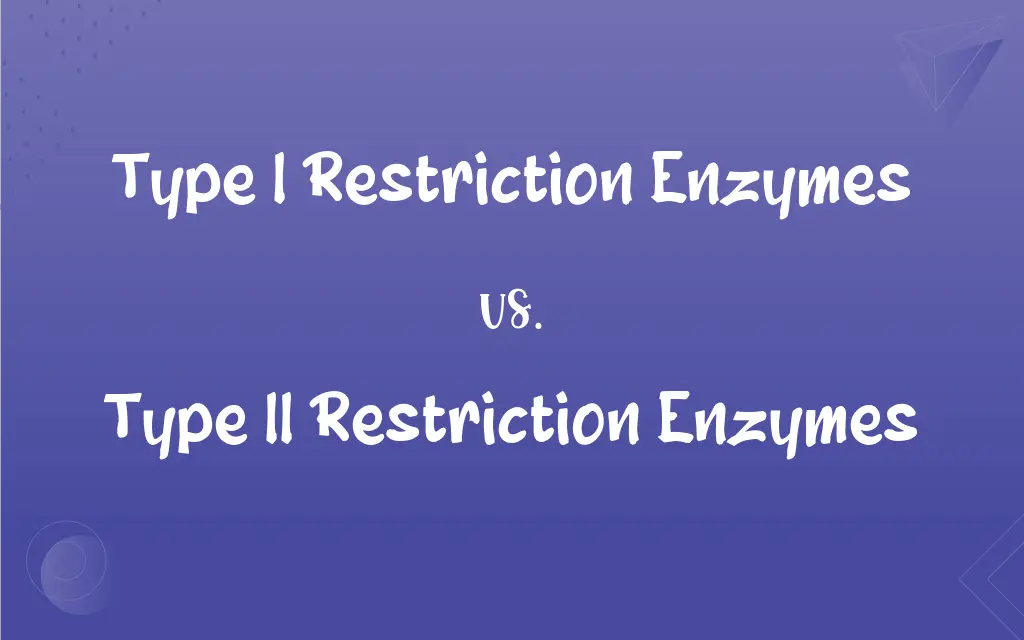Type I Restriction Enzymes vs. Type II Restriction Enzymes: What's the Difference?
Edited by Janet White || By Harlon Moss || Updated on October 17, 2023
Type I restriction enzymes cleave DNA randomly away from recognition sites; Type II cleave at or near specific recognition sites.

Key Differences
Type I restriction enzymes are multifunctional protein complexes that recognize specific DNA sequences. In contrast, Type II restriction enzymes are simpler proteins that also recognize specific sequences but act differently.
When Type I restriction enzymes recognize their specific DNA sequences, they introduce breaks at random locations away from these recognition sites. On the other hand, Type II restriction enzymes cleave DNA at or very near their recognition sequences.
Another notable distinction is the multifunctionality of Type I restriction enzymes. They possess both restriction (cutting) and methylation (chemical modification) activities. In stark contrast, Type II restriction enzymes are primarily known for their cutting activity without associated methylation.
Type I restriction enzymes are more complex and need energy (ATP) to function. Type II restriction enzymes do not need external energy sources to act, relying solely on the energy from the DNA substrate's conformation.
In the realm of molecular biology and genetic engineering, Type II restriction enzymes have become more popular and widely used because of their predictability and precision. Meanwhile, the less predictable cleavage patterns of Type I restriction enzymes have made them less common in routine laboratory applications.
ADVERTISEMENT
Comparison Chart
Cleavage Location
Randomly away from recognition site
At or near the recognition site
Complexity
Multifunctional protein complexes
Simpler proteins
Methylation Activity
Yes
No
Energy Requirement
Requires ATP
Does not require external energy
Usage in Lab
Less common
Widely used in molecular biology applications
ADVERTISEMENT
Type I Restriction Enzymes and Type II Restriction Enzymes Definitions
Type I Restriction Enzymes
DNA-modifying enzymes requiring energy to function and possessing methylation activity.
The unique methylation pattern was indicative of the presence of a Type I restriction enzyme.
Type II Restriction Enzymes
Molecular scissors used in labs to cut DNA at defined sites.
The DNA fragment of interest was isolated using a Type II restriction enzyme.
Type I Restriction Enzymes
Multifunctional proteins recognizing specific DNA sequences and cleaving away from them.
Researchers found that the DNA was cleaved randomly due to the action of a Type I restriction enzyme.
Type II Restriction Enzymes
Enzymes making precise DNA cuts at their recognition sites.
The predictable action of the Type II restriction enzyme made it ideal for the research study.
Type I Restriction Enzymes
Complex proteins that cut DNA at non-specific sites distant from recognition sequences.
Using a Type I restriction enzyme, the DNA sample showed unexpected cleavage patterns.
Type II Restriction Enzymes
Simple enzymes widely used in genetic engineering due to their predictability.
For the cloning experiment, they chose a Type II restriction enzyme for precision.
Type I Restriction Enzymes
DNA-cleaving enzymes that act away from their recognition sites and require ATP.
The need for ATP in the reaction hinted at the involvement of a Type I restriction enzyme.
Type II Restriction Enzymes
DNA-cutting proteins not requiring external energy sources to function.
Without the need for ATP, the Type II restriction enzyme efficiently cleaved the DNA.
Type I Restriction Enzymes
DNA processing enzymes that show restriction and modification activities.
Through its dual functionality, the Type I restriction enzyme both modified and cleaved the DNA.
Type II Restriction Enzymes
Proteins that recognize and cleave DNA at or near specific sequences.
The precise cuts in the DNA were made using a Type II restriction enzyme.
FAQs
Do Type I restriction enzymes have methylation activity?
Yes, Type I restriction enzymes possess both restriction and methylation activities.
Are Type II restriction enzymes used widely in labs?
Yes, due to their precision, Type II restriction enzymes are popular in molecular biology.
What are Type I restriction enzymes?
Type I restriction enzymes are multifunctional proteins that recognize specific DNA sequences and cleave away from these sites.
Which enzyme is more predictable in DNA cleavage?
Type II restriction enzymes offer more predictable cleavage patterns.
Are there commercial sources for these enzymes?
Yes, many biotech companies produce and sell both types of enzymes for research purposes.
Why are Type I restriction enzymes less common in labs?
Their less predictable cleavage patterns make them less favored for routine applications.
Are there other types of restriction enzymes beyond Type I and Type II?
Yes, there are other types like Type III and Type IV, each with distinct characteristics.
Why do Type I enzymes need ATP?
ATP provides the necessary energy for their complex cleavage and modification activities.
Can these enzymes be used in DNA fingerprinting?
Yes, especially Type II enzymes, due to their specific cleavage patterns, are useful for DNA fingerprinting.
Which enzyme requires ATP?
Type I restriction enzymes require ATP to function.
Is cleavage by Type II restriction enzymes predictable?
Yes, they cleave at or near their recognition sequences, making them predictable.
Which enzyme cleaves DNA away from recognition sites?
Type I restriction enzymes cleave DNA at random locations away from recognition sites.
Which enzyme is simpler in structure?
Type II restriction enzymes have a simpler protein structure.
Can Type II restriction enzymes act without external energy?
Yes, they do not require external energy and act based on the DNA substrate's conformation.
Are Type II enzymes important for genetic engineering?
Yes, their precision and predictability make them crucial for genetic engineering tasks.
Can both enzymes be used for DNA cloning?
While both can be used, Type II enzymes are preferred for cloning due to their precision.
What's the significance of the recognition site?
It's the specific DNA sequence where the enzyme binds and, based on the enzyme type, either cleaves at or away from.
How do Type II restriction enzymes differ?
Type II restriction enzymes recognize specific DNA sequences and cleave at or very near these sites.
Do Type II restriction enzymes possess methylation activity?
No, Type II restriction enzymes primarily have cutting activity without associated methylation.
What's the role of methylation in Type I restriction enzymes?
Methylation in Type I enzymes helps protect the host DNA from its own restriction activity.
About Author
Written by
Harlon MossHarlon is a seasoned quality moderator and accomplished content writer for Difference Wiki. An alumnus of the prestigious University of California, he earned his degree in Computer Science. Leveraging his academic background, Harlon brings a meticulous and informed perspective to his work, ensuring content accuracy and excellence.
Edited by
Janet WhiteJanet White has been an esteemed writer and blogger for Difference Wiki. Holding a Master's degree in Science and Medical Journalism from the prestigious Boston University, she has consistently demonstrated her expertise and passion for her field. When she's not immersed in her work, Janet relishes her time exercising, delving into a good book, and cherishing moments with friends and family.































































